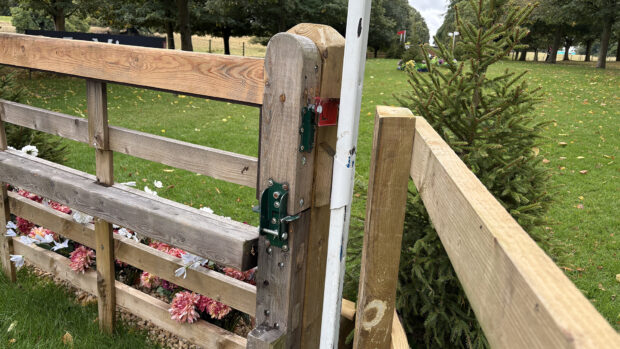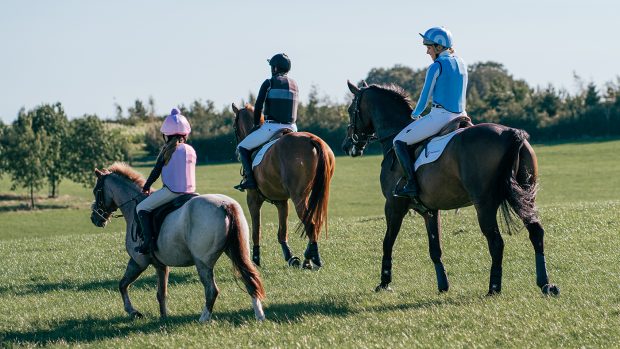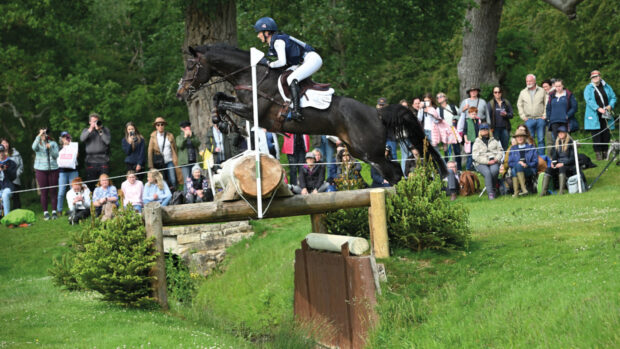Could eventing’s picturesque keyhole fences become a relic of the past, as riders, trainers and course-designers debate their value — and risk?
William Fox-Pitt’s serious horse fall at the famous Hibou de Lion at the young horse World Championships two months ago has brought this spectacular type of fence into the spotlight. And back in 1997, Irish rider Samuel Moore was killed in a fall at a keyhole at Blenheim.
But it’s not just about this little hole, through which horses burst so impressively; riders are questioning whether some horses — however brave and well trained — simply never jump safely over a fence with something overhead.
| Related articles |
The fence at which Andrew Nicholson suffered neck fractures earlier this year had a banner above; two years ago Harry Meade broke both his arms at another roofed fence. Harry has had just two falls in the past six seasons, both at roofed fences, which he says were “definitely the cause”.
“Fences with roofs have a unique characteristic that can make some horses react differently, totally irrespective of how brave or careful they are, and how well you have presented them,” he told H&H. “The majority don’t mind them, but some horses will duck whatever happens.”
Pushing the guidelines
The Hibou, a table within an owl hole (pictured, above) in the seven-year-old class designed by Pierre Michelet at Le Lion, jumped poorly all day this year.
Although it caused only a handful of refusals, there were two horse falls, and several horses left legs.
The winner, Laura Collett, had a refusal on her first horse, and said the fence’s position “made it more influential than normal”.
“It blended in with the trees, and the steep slope on the landing side made horses more cautious,” she said.
Janou Bleekman, the other rider beside William whose horse fell, agreed that the siting of the fence made it difficult to read.
“It was coming down a hill — so tricky on a tired horse at the end of a course — and was camouflaged,” she said. “It was also a wide fence, like diving through a thick tunnel. As it was all brown, maybe horses thought the fence was brush, not solid.”
In fact, this flouts FEI guidelines on “hole fences”, which state that “any surface that can be touched by the horse must always be soft”. British Eventing suggests “at least 25cm brush above the solid part of a keyhole fence”.
The fact that this fence was wide, too, is noteworthy. Guidelines suggest “no more than 50% of the maximum width for the class should be used at keyholes”, and this table was within limits. However, renowned course-designer Mike Etherington-Smith, who is undertaking a review of all course- designing guidelines, is against any spread at all on keyhole fences.
“All course-designers are aware of the guidelines as they stand,” he told H&H.
“We have to take into account the sun, the spread — if any, ideally none in my opinion — the minimum size of the hole, the solid part of the fence, which must be low, the general siting, and how, when and if they are used.”
The Le Lion team told H&H that the “Hibou is an iconic fence that has had a good history”.
“The fence has been used since 1998, meaning some 1,700 horses have jumped it, and Jean-Michel Foucher [Le Lion director] cannot remember any other serious fall,” said 2015 technical delegate Andrew Fell.
“It is moved around and has previously been jumped in this location. The ground jury walked the course and foresaw no problems, and no rider reps made any comments. At this stage Jean-Michel and Pierre Michelet have made no decisions about its future.”
Ducking and diving
Keyholes have been scrutinised due to William’s injury, but six-time Badminton winner Lucinda Green told H&H that injuries to three top riders at fences with something overhead had “centred” her thoughts.
“I think it’s time they went,” she said. “What bothers me is that it isn’t a training issue — some horses duck, some don’t. It’s as if some horses can’t see them properly, so I don’t feel they are a fair test of trust. It goes against their flight initiative and the way they see.”
Vet Andy Matthews said a horse’s near 360° vision affects the way they tackle these fences.
“Horses are an evolved prey species, highly tuned to ambush predators, who have no enthusiasm at all for entering ‘the lair of the cave bear’,” he said.
American trainer Cathy Wieschhoff, who has ridden at Burghley, said she does not feel they are “an appropriate question”.
“Skinnies and corners test accuracy, but jumping blind with a roof overhead and the sides closing in? I’m not sure where you’d find that question in the military adaptation of the sport,” she said.
Harry added that while you can ride other fences with extra positivity, how a horse tackles roofed fences is out of your control.
And whereas most fences can be practised in a manner of guises with forgiving poles, a keyhole is impractical and expensive.
So what does the future hold? Mike would not be drawn on exactly which fences he’s analysing, but hinted that “some of the guidelines could become rules”.
Keyholes make a stunning photo, but potentially one that won’t be adorning programmes forever.
Jumping through fire
If a police horse, often with less athletic ability than an eventer, can jump through a blazing hoop, why do we see problems with eventers and key holes?
Craig Richards, sergeant of the mounted branch of the Metropolitan Police, detailed a training schedule that would not be feasible for an eventer required to assess a new fence at speed. Police horses practise repeatedly over exactly the same fence, often with a lead.
“We start over narrow blue boxes that the hoops sit on, then add wings, so it’s very gradual,” he says. “Once you introduce the hoops, they’ve jumped those blue boxes many times, and we’ll always give a lead to less confident horses. I’d certainly never jump a horse through one who had never done it before.”
Should they stay or go?
Harry Meade: “I’m reluctant to say anything should be banned, but these fences shouldn’t be overused or gimmicky.”
Laura Collett: “I don’t think keyholes need to be reviewed but where they are placed needs to be thought about from the horses’ point of view.”
Clarissa Bleekman: “It’s a hard balance: the easier you make a course, the faster riders go. You can’t keep making fences safer forever.”
Lucinda Green: “I have concerns about fences with any kind of roof.”
Cathy Wieschhoff: “Claustrophobia is a factor with keyholes and I don’t think that’s an appropriate question.”




